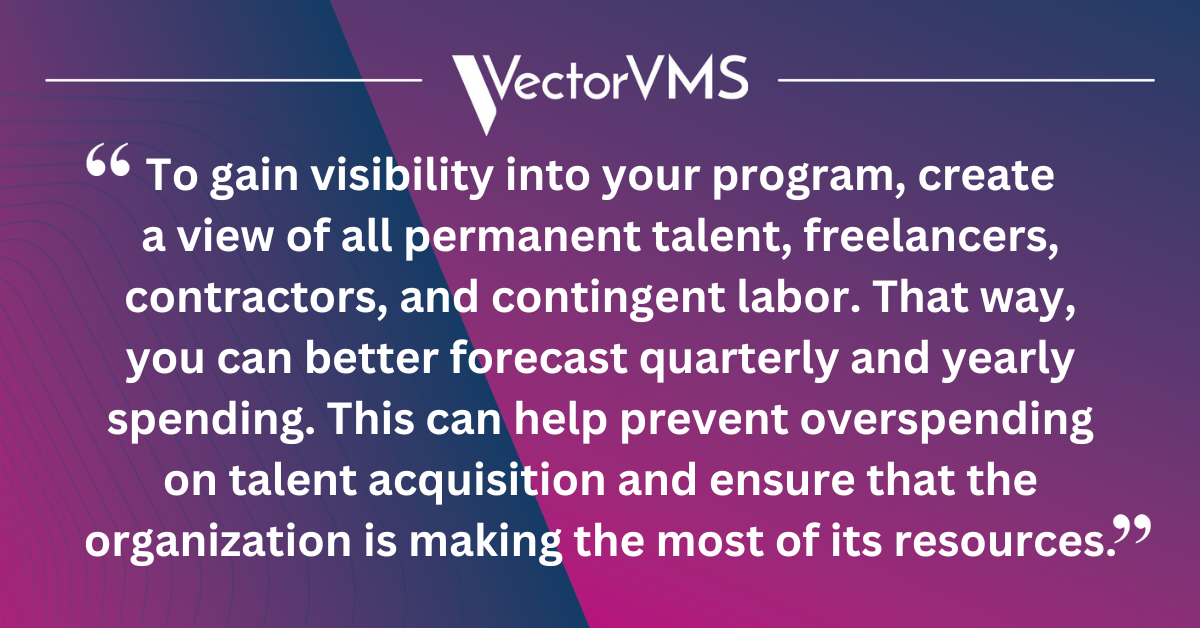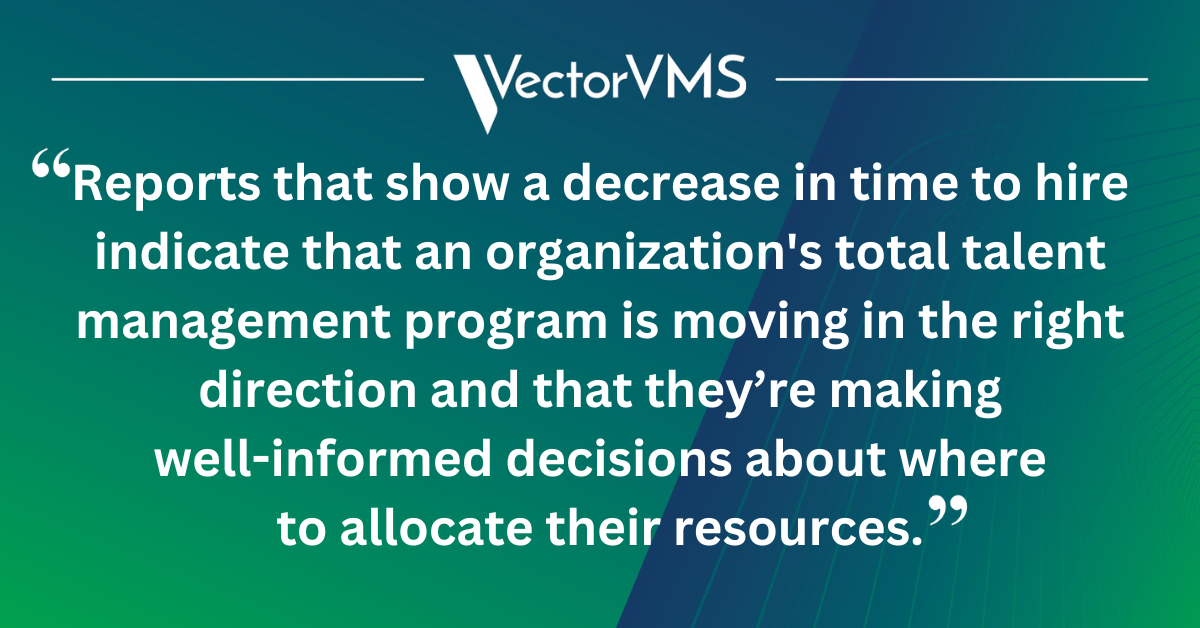Total talent management lets you change your talent acquisition landscape by discovering where talent is, what their pay expectations are, and how long it takes to hire. This allows you to make better-informed decisions about talent integration, diversity, demand management, and oversight. Coupled with a Vendor Management System (VMS), it can become an on-demand talent-sourcing machine.
While total talent management can be incredibly beneficial, it’s important that organizations establish from the beginning how to measure the success of their program. Without clear metrics in place, it can be difficult to gauge the effectiveness of talent acquisition strategies and make well-informed decisions about where to allocate resources.
When you have a job opening, you’ll evaluate the entire talent pool to identify the best fit for the position and find the most effective way to bring those individuals into the company. After picking out potential candidates, you can then assess the available talent and decide how to fill the job opening. To then measure the success of that process, you must look at various parameters. Here are the top 5 you must include in your strategy:
1) Process and Spend Visibility of All Talent
Process and spend visibility of all talent is a critical component of any total talent management program. By gaining a more comprehensive view of your entire talent pool, organizations can enhance their ability to allocate resources, improve their workforce management processes, and reduce the risk of potential issues or errors.
To gain visibility into your program, create a view of all permanent talent, freelancers, contractors, and contingent labor. That way, you can better forecast quarterly and yearly spending. This can help prevent overspending on talent acquisition and ensure that the organization is making the most of its resources.
MORE ABOUT TOTAL TALENT | ‘Build Your Total Talent Management Dream Team: Who to Include and Why’

2) Total Cost to Hire Talent
This refers to the actual cost associated with hiring an employee and getting them started in the company. It includes not only the cost of recruiting and onboarding, but also the cost of benefits, training, and any other expenses that may be incurred during the hiring process. When you track this metric, you gain a better understanding of the true cost of bringing new talent into the company, allowing you to make better-judged decisions about where and how to allocate resources.
3) Percentage of Direct Hires
Where are you sourcing talent from, and are you able to source on demand? How many silver-medal candidates have you identified for contingent jobs or other roles within the company?
Tracking the percentage of direct hires provides insight into the organization’s ability to attract and retain top talent. High percentages of direct hires can imply that the organization has a strong employer brand and effective recruitment strategies, while low percentages may suggest that the organization is struggling to compete for top talent. Additionally, tracking the percentage of direct hires can help organizations identify areas where they may be overspending on staffing agency fees or other intermediary costs.
LEARN MORE | ‘Direct Sourcing: A Cost-Saving Strategy to Improve Finances in a Contingent Workforce Program’
4) Cost Containment
Cost containment is a crucial parameter to monitor in total talent management. It helps you understand whether the cost associated with sourcing and hiring candidates has been reduced. Decreased costs show that the organization is making the most of its resources and achieving maximum returns on its investment in talent acquisition and management.
YOU MIGHT LIKE | ‘3 Strategies for Maintaining Healthy Finances With Vendors in a Contingent Workforce Program’
5) Time to Hire
Time to hire is an important parameter to track in total talent management. By establishing a “before” and “after” picture of the speed of the worker integration process, organizations can determine if their new internal and external talent pools are helping to reduce the time it takes to fill open roles. Reports that show a decrease in time to hire indicate that an organization’s total talent management program is moving in the right direction and that they’re making well-informed decisions about where to allocate their resources.

How to Measure Success
Once you have your systems in place, it’ll be easier to track the success of your program. There are many different metrics you can use to determine if your project is moving in the right direction. These include:
- Decreased time to fill open roles
- Increased number of applicants available for open positions
- Decreased costs associated with sourcing and hiring top talent
- Greater visibility across the entire workforce, as evidenced by:
- Number of workers you have regardless of status
- Upcoming roles that can be passed across systems
- Cost of employment across departments and role types
Once you have your metrics defined and tracking at a regular pace, you can continue to make adjustments to your total talent management strategy for continuous improvement.
Total Talent Management Begins Here
Regardless of how contingent and non-contingent labor fit into your future strategy, a total talent management approach will prove invaluable. Organizations that think in terms of total talent are more resilient, enjoy greater scalability, and have a better sense of their current capabilities and the best route forward with future resourcing decisions.
This isn’t to say that total talent management is an easy win, or even an easy sell to the rest of the organization. It requires you to assemble the right people and the right technology, and when it’s up and running, it’ll need the right checks and balances to ensure that you’re maximizing its full potential. Nonetheless, it’s a project worthy of passion, and one that stands to meaningfully boost your organizational culture and quality of hire.
If you want to learn more about how to build a strong total management process, download our ebook ‘Total Talent Management: 3 Considerations for Revolutionizing the Way We Manage Talent.’ Alternatively, contact us—we’d be happy to help!
 Meet the Expert
Meet the Expert
Taylor Ramchandani – VP of Strategy
Taylor Ramchandani is responsible for the management and strategic planning of the VectorVMS vendor management system. Taylor is committed to client satisfaction and to ensuring VectorVMS technology meets the current and future needs of clients and managed service providers (MSPs). She uses market research and in-depth industry experience to create products and services that make extended workforce management efficient and intuitive. Taylor oversees product development, marketing, and business partnerships for VectorVMS and is responsible for driving innovation for contingent workforce management. Connect with her on LinkedIn.



